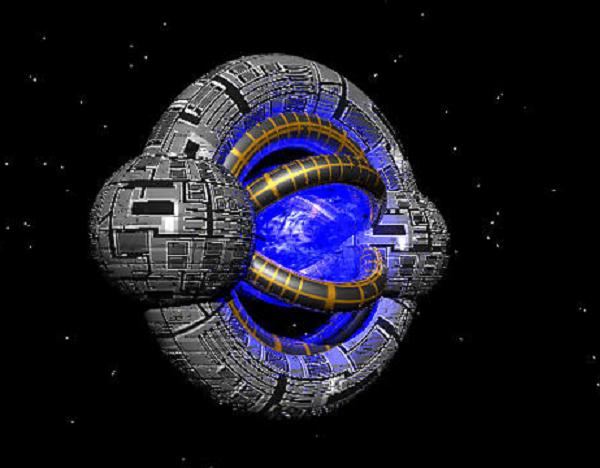BY LETTER
Displacement Drive
Technology > Application > Transportation > Interstellar Transport
Technology > Application > Transportation > Propulsion Technology
Technology > Technology Type or Material > Space-Time Engineering
Technology > Technology Levels > Transapientech / Godtech / Clarketech
Technology > Application > Transportation > Propulsion Technology
Technology > Technology Type or Material > Space-Time Engineering
Technology > Technology Levels > Transapientech / Godtech / Clarketech
Spacecraft containing, and propelled by, miniature space-time warps known as Void Bubbles. | |
 Image from Todd Drashner | |
| Displacement drive vessels use void bubble based drive nodes which are enclosed within the ship | |
Externally, such void bubbles are essentially invisible, as their apparent size is very small indeed. By manipulating the folded space they are made of, such void bubbles can be made to move in relation to the larger space we live in. This action is completely reactionless, and even better for space travel, the mechanisms and matter inside the void bubble is not really IN our spacetime. As a result, all of the mass in the void bubbles is not subject to relativistic mass increase. Sadly, at S:4 the void bubbles created are relatively small, and worse, the bubbles cannot be undone non-destructively. This means that the bubbles are one-use only: Once the fuel within them is expended, they cannot be salvaged. Once an S:4 void bubble collapses, everything within is destroyed catastrophically.
At S:4, these devices are typically used as engines for more conventional vessels. These ships are then called "Displacement Ships" as their engines are displaced out of normal space. In the Displacement drive configuration, void bubble based drive nodes, operating in either the Alcubierre or Natario configuration, are enclosed within one or more magnetic containment vessels aboard the ship. The drive nodes are magnetically linked to the vessel within the containment volumes and react against it as they move, effectively pushing or pulling the ship across space with no ejection of reaction mass.
The use of void bubbles this way is commonly referred to as Displacement Drive. The bubble or bubbles are coupled magnetically to a cargo/crew pod, which is then equipped with a power source and active defenses similar to those of a high powered Conversion ship. Such ships can accelerate much harder than even Conversion ships, and do not have the deadly drive ray to worry about either, making them extremely handy and safe compared to earlier technologies.
S:4 Void bubbles are a tremendous advance, as they are far more energy economical than Conversion drives. The range limitations of an S:4 Void bubble are determined by the total mass that can be placed within the bubble and used as fuel, which is fixed when the bubble is made. Although Displacement drives allow continuous accelerations without the use of reaction mass, they provide no protection against acceleration forces and are limited in their performance by the robustness of their cargo and passengers.
In general, S:4 void bubble ships have a range of 1000 or more lightyears and a top speed limited only by the amount of fuel mass the ship captain is willing to convert to energy to expend on chasing lightspeed. In practice, few S:4 void bubble ships exceed 0.84c on a routine basis, in order to squeeze the longest possible lifespan out of the expensive drive bubbles. In theory, any bubble drive ship is able to reach at least 0.98c if it has the fuel mass.
Related Articles
Appears in Topics
| Interstellar Transport | Propulsion Technology | Space-Time Engineering |
| Transapientech / Godtech / Clarketech |
Development Notes
Text by Adam Getchell, Todd Drashner, Mark Mcamuk, and Chris Shaeffer
Initially published on 09 December 2008.
Initially published on 09 December 2008.






